
|   |

|   |
 e-mail: leelakaverivenkat@gmail.com Inclusive Debadhara Photos: Rahul Naag November 25, 2018 Bharat Utsav, as the two-day festival of Debadhara Delhi was titled, showed up the inclusive nature of the organization started in the name of late Odissi Guru Debaprasad Das - with half hour slots of Odissi, Bharatanatyam, Kathak and Mohiniattam being sponsored by them at the IIC auditorium. Indeed Debadhara is projecting itself as a strong supporter of all dance forms and an events manager - overriding its image as an institution producing young Odissi dancers. While applauding the festival organization, one pondered on some things which could perhaps be thought over. For instance, the start with screening of a film on the generous sponsor (but for whose support this festival could not have been held) followed by an Odissi presentation by the youngsters of Debadhara, not to speak of the inaugural formalities with chief guests from the bureaucratic world, the actual program scheduled to begin at 6.30pm, began a good forty minutes late on both days. Also does every dancer after a few years in the field, become a 'Bidushi?' This word is being devalued like the word 'guru'. Will not dancer so and so do? 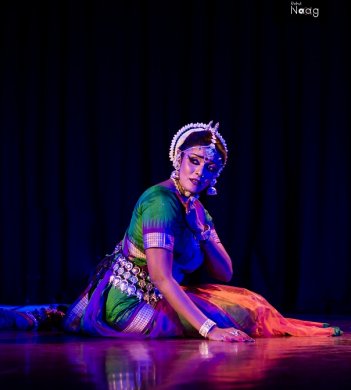 Sandhya Manoj Sandhya Manoj from Malaysia is certainly a very finished dancer with an unusual feel for mukhabhinaya and its subtle variations. With Ratikant Mohapatra's assistance in Bhubaneswar (though the announcement said that she belonged to the Debaprasad school) with a Sanskrit text written by Bhubaneswar scholar Nityananda Mishra (shades of Jayadeva's Gita Govind could be sensed, though Radha here was shown as very conscious of her own physical charms) not excluding well composed music in the ragamalika form ending with Bhairavi, all the Ashta Nayikas from Vasakasajja, to Virahotkhanthita, to Vipralabdha to Abhisarika (with the inevitable thorn, snake and other details while trudging through the dark night) to Khandita, Kalahantarita, Proshitabhartrika, Swadheenapatika were brought out through abhinaya - though the work towards the end seemed to drag. 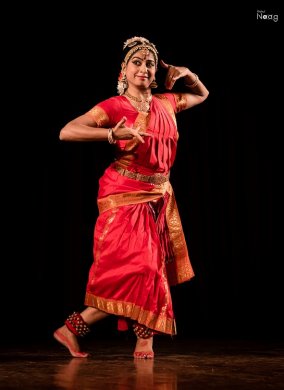 Aparajita Sarma Aparajita Sarma, daughter of Bharatanatyam Guru Kanaka Sudhakar, showed herself to be a vibrant dancer, her Bharatanatyam lines articulated with an assertive quality demanding audience attention. The portrayal of Devi as Simhavahini to music in Ranjini, as Mahishasuramardhini and as "Omkara Nada Roopini" (notwithstanding a slightly exaggerated quality at odd moments in expression and stance with the araimandi hyped to a mukkalmandi with too much of a squat), was generally very convincing. The earlier group of three other students of Kanaka Sudhakar performing "Shankara Sri Giri" in Hamsanandi, had been well taught -and the choreographic ideas would have stood out better with a less dissimilar group in terms of physical appearance and height. But what marred was the "Om Namashivaya" chant which was off key and a superimposition on the recorded music which was not needed. 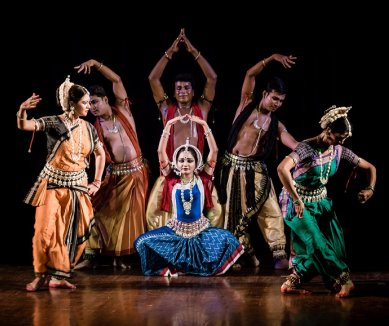 Darshan Odissi group The Darshan Odissi group, comprising dancers groomed under late Guru Gangadhar Pradhan, in professional finish are a credit to their Guru. Beginning with frozen postures reminiscent of the Konark sculptures, the Sabda/swara/patha type of recitation with Bols "Ta thai indakitataka ta hamta hat tat ta" and the movements were much like a Sthai composition. This was followed by the Jayadeva Gita Govinda verse line "Vedanudharate Jagannivahate..." with vignettes of the ten incarnations of Vishnu. Rendered to the music set by Subhash Pani, with the chant "Krishnamaya Tubhyam Namah" as a link between incarnations, this seems to be a great favourite of this group, and one must admit it is well synchronized with both group arrangements and mood of each avatar compulsively brought out. 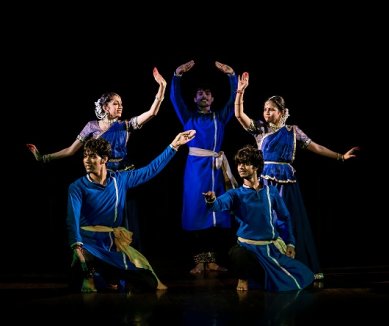 Pt Rajendra Gangani's disciples The evening ended with a Kathak group trained by Rajendra Gangani, the dancers starting with Shiva Vandana and then proceeding to the tala suiting the Lord, namely Dhamar and ended with a neat Sargam in Himangini raga. The chakkars on one leg, had laya accuracy along with balanced movement. 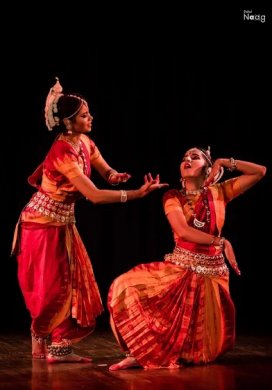 Disciples of Binayak Panda As curtain raiser on the second evening, Ankita Kumari and Eshita Bharati, long time disciples of Binayak Panda, looking good in red and yellow costumes, presented Durga, a fierce manifestation of the Goddess riding the lion. The dance set to Triputa and Ektali was based on the choreography of Gajendra Panda. Simulating anger comes more easily than portraying sringar and one would like to see these youngsters carry off items depicting this mood. 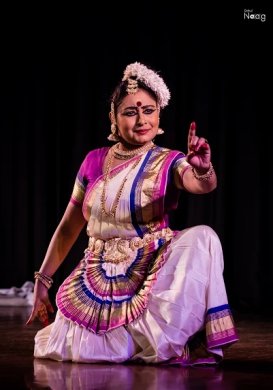 Jayaprabha Menon The best of the evening and a festival high point was the Mohiniattam by Jayaprabha Menon. Along with her students her presentation of "Bhaja Govindam" to music set by late Kavalam Narayana Panicker in the Sopanam mode, showed a rare maturity of abhinaya. This long poem of Shankaracharya, laden with philosophy of the hopelessness of non- evolved man not realizing the inevitability of life and death , while lusting after temporary gains, is not easy to translate into the language of abhinaya with no textual story line as base. But Jayaprabha dealt with it with great flair, and having successfully worked at a trimmer body, her Mohiniattam performance really shone. Even Jeeva, designed for three dancers (two of her students), with the 'Aham Brahmasmi' finish was well thought out. 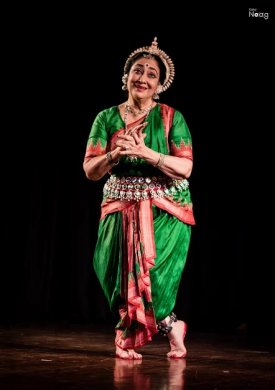 Sharon Lowen Having been away from the performance part of Odissi for quite some time, it was courageous of Sharon Lowen to present the Ashtapadi "Sakhiye keshi mathanam udaram," following which her student Viswanath Mangaraj proved to be a credit to her teaching ability. This youngster has the ability to transcend the gender divide, and his presentation of the Ashtapadi "Rati sukhasare, gata mabhisare" showing the sakhi entreating Radha to end her pangs of desire for Krishna by joining him for he was waiting for her in the woods of the Jamuna bank - hoping and expecting in every leaf stir or feather falling to the ground the foot steps of his beloved Radha. In the interpretation of the opening line "Dheera sameere Yamuna teere vasati vane vanamali", the dancer had already brought in the beginnings of the mood of love. His unselfconscious ease while portraying the sakhi or Radha, with Parvati Brahmachari's vocal support and Guru Kelucharan Mohapatra's magic playing of the mardal, prove that this young man is a dancer to look out for. 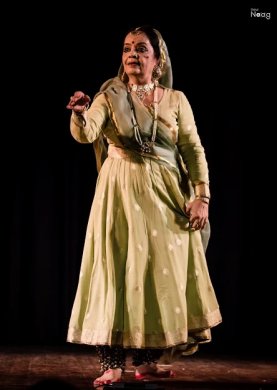 Prerana Shrimali Prerana Shrimali's Kathak performances never have a jaded or already seen feel. She began unusually with an invocation to the country based on poetry of Jayashankar Prasad, "Arun yeh madhumaya desh hamara." Her teental vilambit, right from the tatkar opening in the nritta had the quality of flowing water and of music in its variety of accented and unaccented syllables and one realized how nritta in Kathak, far from being an aggressively exhibitionistic rendition can be unhurried, and so musical in its language of bols and footwork. With a Kavit on Saraswati, Parmelu, and a very graceful gatnikas where the takeoff point was a fraction before the start of the tala avartan, it was a magical presentation with her Guru's son Rajendra Gangani himself doing honours with padhant and the other son, Fatehsingh Gangani providing again very melodious tabla support. And the singer, yet another from the Gangani brood, Sandeep Gangani, sang mellifluously the Maand Meera Bhajan. Here addressing "Sundar Badana" Krishna, Meera wonders why this teasing and delightful sporting with Gopis seems to disappear before her in a 'Bhramachari' front. Altogether a wonderful end for the festival!  Writing on the dance scene for the last forty years, Leela Venkataraman's incisive comments on performances of all dance forms, participation in dance discussions both in India and abroad, and as a regular contributor to Hindu Friday Review, journals like Sruti and Nartanam, makes her voice respected for its balanced critiquing. She is the author of several books like Indian Classical dance: Tradition in Transition, Classical Dance in India and Indian Classical dance: The Renaissance and Beyond. Post your comments Please provide your name and email id when you use the Anonymous profile in the blog to post a comment. All appropriate comments posted with name & email id in the blog will also be featured in the site. |